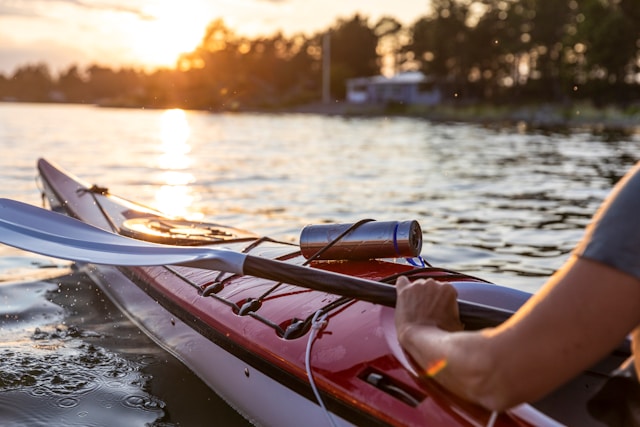Going solo on a canoe camping trip is an amazing way to connect with nature and yourself. It’s a chance to truly disconnect from the daily grind, challenge yourself physically and mentally, and discover a renewed appreciation for the wilderness. The solitude allows for deep introspection and a profound connection with the natural world, unlike any other experience. But planning a successful solo trip requires careful preparation, meticulous attention to detail, and a proactive approach to safety. Unlike group trips where responsibilities are shared, you’re entirely responsible for your safety and well-being, making thorough planning absolutely critical. This comprehensive guide helps you plan your first solo overnight canoe camping trip. It’s all about being prepared, staying safe, and maximizing your enjoyment of this incredible adventure.
Gear Up for Success: Packing Light and Smart
Packing light is absolutely crucial for solo canoe trips. Every extra pound you carry significantly impacts your paddling efficiency and overall enjoyment, potentially turning a relaxing trip into a grueling ordeal. A well-chosen, lightweight tent is paramount; consider models specifically designed for backpacking or canoeing. Similarly, your sleeping bag should prioritize warmth-to-weight ratio. A compact and efficient cooking system is essential; consider lightweight options like alcohol stoves or mini-camp stoves. Don’t forget a dry bag to protect your electronics, maps, and other valuables from the elements – a soggy map is about as useful as a screen door on a submarine! Navigation is key, so pack a map and compass; thoroughly learning how to use them *before* your trip is not optional – it’s a matter of safety. A reliable GPS or, even better, a satellite messenger can be a lifesaver, especially when traveling alone, as it can quickly summon help in case of an emergency. Always tell someone your detailed itinerary – including launch point, planned route, campsites, and expected return time – and check in regularly with that person.
Essential Safety Gear: Prioritizing Preparedness
Safety shouldn’t be an afterthought; it should be the cornerstone of your planning. A well-stocked, comprehensive first-aid kit is absolutely non-negotiable. Pack extra food and water—significantly more than you think you’ll need—and always bring reliable water purification tablets or a filter. A whistle, not just for calling for help, but also to communicate if you get separated from your group (even if that group is just you!), headlamps with extra batteries, and a reliable multi-tool are essential. Knowing basic first aid and wilderness survival skills is not just valuable; it is potentially life-saving. Seriously consider taking a wilderness first-aid course before you go; you’ll thank yourself later if anything goes wrong. Understanding your surroundings, potential hazards (weather, wildlife, water conditions), and having a solid plan B, are all paramount before you even touch the water.
Choosing Your Location and Route: Research and Planning are Key
Choosing the right location and route are fundamental to a successful and enjoyable solo trip. Begin by thoroughly researching potential paddling destinations, taking into account your skill level and experience. Consider factors like water conditions (currents, rapids, potential hazards), the difficulty level of the route, the availability of campsites (and whether reservations are required), and the overall distance. Opt for well-established routes whenever possible, especially as a beginner. This significantly reduces the risk of getting lost or encountering unexpected and potentially dangerous obstacles. Carefully study detailed maps and charts, paying close attention to potential hazards such as rapids, strong currents, shallow areas, and portages. Plan your route based on your skill level, the available daylight hours, and your planned paddling pace (remember, solo paddling requires more exertion). If you’re a novice, keep your initial trip short, choosing a route with well-marked campsites and minimal challenging sections.
Making Reservations and Permits: Respecting Regulations
Many popular canoe camping destinations require reservations or permits to protect the natural environment and manage the number of visitors. Research necessary permits well in advance, and book campsites very early, especially during peak season. This ensures you have a secure place to camp, avoids the major disappointment of arriving and finding everything fully booked, and contributes to the responsible management of these often fragile ecosystems. Being meticulously prepared in advance will make the entire process significantly smoother and help you avoid frustrating or unexpected issues. Always double-check for any specific regulations or restrictions before your trip; this might include rules about campfires, fishing licenses, waste disposal, or quiet hours.
Tips for a Safe and Enjoyable Solo Trip: Prioritize Safety and Self-Reliance
Solo canoe camping demands extra awareness, meticulous planning, and a high degree of self-reliance. Always check the weather forecast multiple times before you go and be prepared to alter or postpone your plans if needed; weather conditions can change rapidly in the wilderness. Inform at least two people about your precise itinerary, including your planned route, campsites, and estimated return time. Paddle predominantly during daylight hours whenever possible; this improves your ability to navigate and significantly reduces the risk of accidents. Practice self-sufficiency in navigation and basic repairs; learn how to use your compass effectively, fix minor equipment problems, and perform basic first aid. Take frequent, regular breaks to rest, eat, and drink plenty of water; this is crucial for maintaining energy levels and preventing exhaustion, a major factor contributing to accidents. Avoid pushing yourself too hard or paddling when you are fatigued. Remember, being tired dramatically reduces your reaction time, increases your risk of accidents, and diminishes your situational awareness. For more detailed safety tips and best practices, resources like the American Canoe Association provide excellent guidance on safe paddling techniques and emergency procedures – check out their website for valuable information: American Canoe Association.

